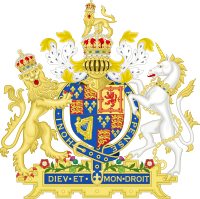
Back Huis van Stuart Afrikaans أسرة ستيوارت Arabic عيلة ستيوارت ARZ Casa d'Estuardu AST Stüartlar Azerbaijani Сцюарты Byelorussian Стюарти Bulgarian Stuart (dinastija) BS Dinastia Stuart Catalan Stuartovci Czech
| Stuart Stewart | |
|---|---|
| Royal house | |
 Coat of arms of James VI and I, 1603–1649 | |
| Parent family | Clan Stewart |
| Country | Scotland, England, Ireland, Great Britain |
| Founded | c. 1371 (654 years ago) |
| Founder | Robert II of Scotland (1371–1390) |
| Final ruler | Anne, Queen of Great Britain (1702–1714) |
| Titles | List
|
| Dissolution | 1807 |
| Cadet branches | |
The House of Stuart, originally spelled Stewart, was a royal house of Scotland, England, Ireland and later Great Britain. The family name comes from the office of High Steward of Scotland, which had been held by the family progenitor Walter fitz Alan (c. 1150). The name Stewart and variations had become established as a family name by the time of his grandson Walter Stewart. The first monarch of the Stewart line was Robert II, whose male-line descendants were kings and queens in Scotland from 1371, and of England, Ireland and Great Britain from 1603, until 1714. Mary, Queen of Scots (r. 1542–1567), was brought up in France where she adopted the French spelling of the name Stuart.
In 1503, James IV married Margaret Tudor, thus linking the reigning royal houses of Scotland and England. Margaret's niece, Elizabeth I of England died without issue in 1603, and James IV's and Margaret's great-grandson James VI of Scotland acceded to the thrones of England and Ireland as James I in the Union of the Crowns. The Stuarts were monarchs of Britain and Ireland and its growing empire until the death of Queen Anne in 1714, except for the period of the Commonwealth between 1649 and 1660.[note 3]
In total, nine Stewart/Stuart monarchs ruled Scotland alone from 1371 until 1603, the last of whom was James VI, before his accession in England. Two Stuart queens ruled the isles following the Glorious Revolution in 1688: Mary II and Anne. Both were the Protestant daughters of James VII and II by his first wife Anne Hyde and the great-grandchildren of James VI and I. Their father had converted to Catholicism and his new wife gave birth to a son in 1688, who was to be brought up as a Roman Catholic; so James was deposed by Parliament in 1689, in favour of his daughters. However, neither daughter had any children who survived to adulthood, so the crown passed to the House of Hanover on the death of Queen Anne in 1714 under the terms of the Act of Settlement 1701 and the Act of Security 1704. The House of Hanover had become linked to the House of Stuart through the line of Elizabeth Stuart, Queen of Bohemia.
After the loss of the throne, the descendants of James VII and II continued for several generations to attempt to reclaim the Scottish and English (and later British) throne as the rightful heirs, their supporters being known as Jacobites. Since the early 19th century, when the James II direct line failed, there have been no active claimants from the Stuart family. The current Jacobite heir to the claims of the historical Stuart monarchs is a distant cousin Franz, Duke of Bavaria, of the House of Wittelsbach. The senior living member of the royal Stewart family, descended in a legitimate male line from Robert II of Scotland, is Andrew Richard Charles Stuart, 9th Earl Castle Stewart.
Cite error: There are <ref group=note> tags on this page, but the references will not show without a {{reflist|group=note}} template (see the help page).